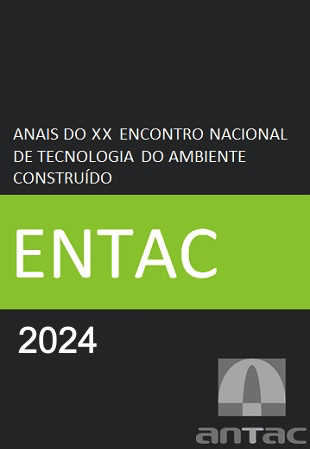Initial phase for the transformation of public assets into digital twins
DOI:
https://doi.org/10.46421/entac.v20i1.6069Keywords:
Digital twin, Public asset, Case study, Observation, VirtualizationAbstract
The technology to turn a physical asset into a digital twin presents as a solution to transform existing buildings into intelligent systems. For the implementation of digital twins, three components are required: the physical and virtual entity, and the data management between of them. The aim of this investigation was to identify the characteristics of the process of capturing the physical object and virtual modeling. The digital cadastral survey process of the Fernando Ferrari Administrative Center there was the study object. This article highlights the technique employed of direct observation, conducted over seven months in 2023. The observation revealed the high effort of modeling teams using point clouds, as well as the management of static data, which influenced a manual process of redoing layouts after the environment was digitalized scanned. This research allowed for contextualizing the initial stage of the process of creating digital twins aimed at the operation and maintenance of public assets in the national scenario.
References
RASHEED, A.; SAN, O.; KVAMSDAL, T. Digital twin: Values, challenges and enablers from a modeling perspective. IEEE Access, [s. l.],
v. 8, p. 21980-22012, 2020. DOI: 10.1109/ACCESS.2020.2970143
GARCIA, A. et al. Aplicação de gêmeos digitais na indústria da construção: estado da arte. In: CONGRESSO PORTUGUÊS DE
BUILDING INFORMATION MODELLING, 4., 2022, Braga. PTBIM. Braga: Universidade do Minho, 2022. p. 522-533. v. 1.
OPOKU, D.-G. J. et al. Digital twin application in the construction industry: A literature review. Journal of Building Engineering,
Amsterdam, v. 40, 102726, ago. 2021. Disponível em: https://www.sciencedirect.com/science/article/abs/pii/S2352710221005842.
Acesso em: 28 maio 2024.
BOJE, C. et al. Towards a semantic construction digital twin: Directions for future research. Automation in Construction,
Amsterdam, v. 114, 103179, jun. 2020. Disponível em: https://www.sciencedirect.com/science/article/pii/S0926580519314785.
Acesso em: 28 maio 2024.
DELGADO, M. D.; OYEDELE, L. Digital twins for the built environment: Learning from conceptual and process models in
manufacturing. Advanced Engineering Informatics, Amsterdam, v. 49, 101332, ago. 2021. Disponível em: https://
www.researchgate.net publication/352437867_Digital_Twins_for_the_built_envionment_learning_from_conceptual_and_process_
models_in_manufacturing. Acesso em: 28 maio 2024.
SICCARDI, S.; VILLA, V. Trends in adopting BIM, IoT and DT for facility management: A scientometric analysis and keyword co-
occurrence network review. Buildings, Basel, v. 13, n. 1, 15, 21 dez. 2022. Disponível em: https:/www.mdpi.com/2075-5309/13/1/15.
Acesso em: 28 maio 2024.
KHAJAVI, S. H. et al. Digital twin: Vision, benefits, boundaries, and creation for buildings. IEEE Access, [s. l.], v. 7, p. 147406-147419,
DOI: 10.1109/ACCESS.2019.2946515
SCHÖNFELDER, P. et al. Automating the retrospective generation of As-is BIM models using machine learning. Automation in
Construction, Amsterdam, v. 152, 104937, ago. 2023. Disponível em: https://www.sciencedirect.com/science/article/pii/
S0926580523001978. Acesso em: 28 maio 2024.
EL-DIN, M. N. et al. Digital twins for construction assets using BIM standard specifications. Buildings, Basel, v. 12, n. 12, 2155, 7 dez.
Disponível em: https://www.mdpi.com/2075-5309/12/12/2155. Acesso em: 28 maio 2024.
DENG, M.; MENASSA, C. C.; KAMAT, V. R. From BIM to digital twins: A systematic review of the evolution of intelligent building
representations in the AEC-FM industry. Journal of Information Technology in Construction, [s. l.], v. 26, p. 58-83, 3 fev. 2021. DOI:
36680/j.itcon.2021.005
DIEHL, N. C. Processo de criação de gêmeos digitais: estudo de caso CAFF. 2024. 211 f. Dissertação (Mestrado em Design) –
Universidade Federal do Rio Grande do Sul, Porto Alegre, 2024.
YIN, R. K. Estudo de caso: planejamento e métodos. 5. ed. Porto Alegre: Bookman, 2015. E-book.
RIO GRANDE DO SUL. Secretaria de Planejamento, Governança e Gestão (SPGG). Edital de licitação nº 0071/2022. Termo de
referência para contratação dos serviços de levantamento por nuvem de pontos e modelagem BIM do Centro Administrativo
Fernando Ferrari – CAFF. Porto Alegre, SPGG, jul. 2022. Disponível em: https://www.compras.rs.gov.br/editais/0071_2022/295403.
Acesso em: 28 maio 2024.
DRESCH, A.; LACERDA, D. P.; ANTUNES JÚNIOR, J. A. V. Design science research: método de pesquisa para avanço da ciência e t
tecnologia. Porto Alegre: Bookman, 2015. E-book.
SAMPIERI, R. H.; COLLADO, C. F.; LUCIO, M. D. P B. Metodologia de pesquisa. 5. ed. Porto Alegre: Penso, 2013. E-book.
CENTRO ADMINISTRATIVO FERNANDO FERRARI (CAFF). [Fotos]. Porto Alegre, [2023?]. Disponível em: https://caff.rs.gov.br/
historia/. Acesso em: 28 maio 2024.
GIBBS, G. Análise de dados qualitativos. (Métodos de pesquisa; coord. Uwe Flick). Porto Alegre: Artmed, 2009. E-book.
RIO GRANDE DO SUL. Secretária de Planejamento, Governança e Gestão (SPGG). Portaria SPGG nº 280/2023. Porto Alegre: SPGG,
nov. 2023. Disponível em: https://www.diariooficial.rs.gov.br/materia?id=923110. Acesso em: 28 maio 2024.
ASSOCIAÇÃO BRASILEIRA DE NORMAS TÉCNICAS (ABNT). NBR 15965-2: sistema de classificação da informação da construção.
Parte 2: Características dos objetos da construção. Rio de Janeiro: ABNT, 2012.
ASSOCIAÇÃO BRASILEIRA DE NORMAS TÉCNICAS (ABNT). NBR 15965-4: sistema de classificação da informação da construção.
Parte 4: Recursos da construção. Rio de Janeiro: ABNT, 2021.

